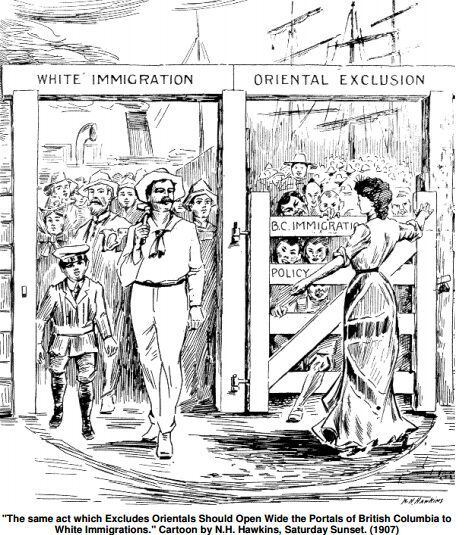 | ||
The Vancouver Anti-Oriental Riots occurred over three days September 7–9, 1907, in Vancouver, British Columbia, Canada. At about the same time there were similar anti-Asian riots in San Francisco, Bellingham, Washington and other West Coast cities. They were not coordinated, but instead reflected common underlying anti-immigration attitudes. Agitation for direct action was led by labour unions and small business. No one was killed but the damage to Asian-owned property was extensive. One result was an informal agreement whereby the government of Japan stopped emigration to Canada.
Contents
Background
The 1907 Vancouver riot was the second act of anti-Oriental violence in the history of Vancouver; the first incident took place in the area of Coal Harbour, in 1887. In the early years of the twentieth century race relations on the Pacific Coast of Canada were strained. There were some sixteen thousand Chinese in the province; in a city of one hundred thousand people or around 8% of the population. There were also 8000 Japanese and around 5000 South Asians. The Chinese had come to Canada to build the railways; the Japanese to fish; and Indians to farm and log.
At this time, other ships with more migrants were turning up—the Suian Maru [300 Japanese], SS Kumeric [1177 Japanese] and the SS Monteagle [901 Indians, further 100 in 1908]. Meanwhile, the Panic of 1907, caused by the failure of Augustus Heinze's brother's bank in New York. exacerbated the labour market and brought racial tensions to the fore. White people perceived Asians as taking "their" jobs. Australia had enacted "White Australia" legislation in 1899 to eliminate Asian immigration. The Asian Exclusion League in Canada lobbied for Canada to do the same.
A riot targeting East Indian lumber workers in Bellingham in 1907 started the events. Soon tensions flared north and angry mobs stormed through Powell Street in Vancouver's China town breaking windows and assaulting Chinese in the streets. The riot lasted 3 days in September 1907, finally the Vancouver police closed the streets and calm slowly returned. Many windows were broken and the population terrified. The second day of the riot turned against the Japanese community. There were similar actions in Steveston in Richmond against the Japanese.
History
Early in 1907 the Grand Trunk and Pacific Railway lobbied Ottawa to let it import 10,000 Japanese workers to build its line in Northern BC [this figure is often misquoted as 50,000]. Premier Bowser did not like such large numbers and was against such a large Asian influx. On August 12, 1907, members of the Asiatic Exclusion League met and developed a resolution. The document asked the Canadian government to "enforce the Immigration Act passed by the provincial legislature in the Spring of 1907", the Canadian Government refused to endorse Act.
At about the same time there were similar anti-Asian riots in San Francisco, Bellingham, Washington and other West Coast cities. They were not coordinated, but instead reflected common underlying anti-Asian nativism. The Vancouver riots were a direct result of the race riot in Bellingham, Washington on September 5, 1907. Many Chinese victims of the Bellingham race riots fled for Canada, subsequently fuelling the Asiatic Exclusion League of Vancouver to take a stance against anti-Asian immigration. 10,000 Canadian and American citizens marched in an anti-Asian immigration parade, which resulted in a mob rioting throughout Chinese and Japanese neighbourhoods within Vancouver, British Columbia, Canada.
At the third meeting, the member of the Asiatic Exclusion League decided to plan a parade for Saturday the 7th of September, which would include a band in order to draw attention. The parade would lead to the Vancouver city hall, next to Chinatown, where a meeting would be held to address the issues of Asian Immigration.
The parade attracted large amounts of Canadians and Americans, "An estimated ten thousand gathered in Vancouver". As various speakers were discussing the Bellingham riot, the sound of shattered glass, a rock tossed by an unruly teen, had sounded the beginning of what would become a much larger riot in Vancouver. The crowd gathered at the parade turned into a rioting mob, throwing beer bottles and rocks at windows, attempting to destroy Chinese owned stores and homes. It is interesting to note, that most of the buildings attacked during the Vancouver riots were Caucasian owned. The mob of rioters moved to Japantown after destroying Chinese business and homes, however, the riots were pushed back by Japanese residents. The Vancouver riot was not finished until 3 o'clock in the morning on September 8, by the time dawn had broken the city was quiet. The Vancouver race riot resulted in zero casualties and a couple thousand dollars worth of property damages.
Causes of riots
The riots that broke out on September 7 of 1907 were the accumulation of growing enmity toward the Asian immigrants that were coming to the United States and parts of Canada. "By the end of October 1907, new arrivals totaled 11,440. Of these immigrants the Japanese accounted for 8,125, the Chinese 1,266, and the Hindus 2,049". As the numbers of Asian immigrants continued to grow anti-Asian activist began to feel threatened that the Japanese could "ultimately control [Vancouver] part of Canada". The riots represented the voices and feelings of anti-Asian activist, in attempt to "convince federal authorities of the seriousness of anti-Japanese sentiment in British Columbia".
Results of riots
Labour Minister MacKenzie King was detailed to write a Royal Commission into the events. He also recompensed the damage with $36,000 to the injured communities. The Vancouver race riot resulted in bans on immigration for Japanese people. This ban was titled the gentlemen's agreement and was enacted in Canada on January 25, 1908. Within this treaty Japan agreed to "restrict the number of passports issued to make labourers and domestic servants to an annual maximum of 400". In addition to the Gentlemen’s agreement, Canada also passed the "Continuous journey" legislation, which allowed Japanese immigrant to "finish" their journey to the United States.
